Why you can trust TechRadar
Much of the Sony RX100 Mark II's design and usability is exactly the same as the original Sony RX100, as you might expect.
It's a sleek offering, fitting neatly into a pocket or bag, without too many protrusions adding to the size, despite the large sensor size. It's around the same size as the Panasonic LF1 or Olympus XZ-10, which both feature much smaller sensors.
The metal chassis helps to give the camera a sleek appearance. Although there's no grip on the front of the camera, it still feels pretty sturdy in the hand, while a small grip on the back of the camera is a good place to rest your thumb.

On top of the camera is a mode dial for switching between the various modes available on the camera, including fully automatic, panoramic mode, and P/A/S/M modes. Handily, there is also a slot labelled MR for "memory recall", which can be used to store a group of settings that you use frequently, such as monochrome, or high ISO.
As with the Sony RX100, the Sony RX100 Mark II is equipped with a 3.6x optical zoom lens, which feels sturdy when extended. It is operated via a traditional switch around the shutter release. Zooming is smooth and fluid, quickly reaching the maximum focal length and retracting back again when you need it.
The back of the Sony RX100 Mark II sees a fairly wide array of different buttons, and as with the Sony RX100 and some other Sony cameras, most of these are customisable depending on how best you like to use the camera.
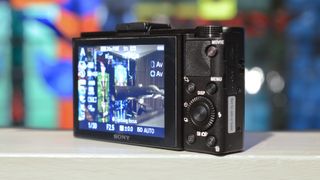
There's a scrolling dial on the back of the camera too for altering parameters such as shutter speed or aperture, depending on the mode you're in.
A function button activates a sort of quick menu, which can also be customised via the main menu. Here you can assign up to seven different types of setting, such as ISO range, digital filters and so on that can be quickly accessed via this button, rather than requiring a delve into the extensive menu.
Although there doesn't appear to be a dedicated delete button, the question mark button that brings up shooting tips when in shooting mode transforms into a delete button when entering playback mode.
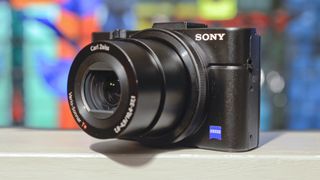
A ring around the lens is also used by default to set the aperture, but again this can be customised to perform another function if you'd prefer. A new addition here is the ability to add a Step Zoom function, that is to have the camera quickly jump between common focal lengths, such as 28mm, 35mm and 50mm simply by rotating the lens dial.
One feature we found particularly useful is the electronic level, which appears on the screen with a couple of presses of the display button. This helps to ensure that horizons are level and is a bonus when lining up your shots.
Including Wi-Fi and NFC on this camera elevates it above the majority of its biggest competitors, aside from perhaps the Panasonic LF1.
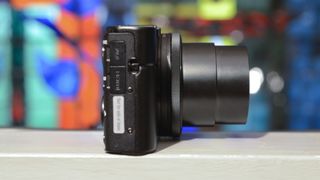
We were able to test out the NFC functionality by pairing it with a Sony Xperia Z smartphone. The camera was able to connect almost instantly.
If you don't have an NFC-compatible device (iPhones aren't compatible, for example), then you can still connect in the standard way by entering a password into your smartphone. Although this is a little more tedious than the instantaneous connection of NFC, it's still relatively quick to set up, and once you've done it once you shouldn't need to do it again.
Via Sony's own PlayMemories app you can control the camera remotely, although this is very limited functionality - only enabling you to fire the shutter release and activate the zoom mechanism.
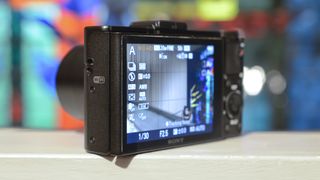
All other parameters, such as aperture and shutter speed, you lose control over. We'd have liked to have seen a more comprehensive amount of control, but perhaps this is something that can be looked at for a future update either to the camera's firmware or the app itself.
The 3-inch LCD screen, which now tilts, has a high 1.229k dot resolution and makes looking through played back images a joy. Using the tilt screen makes it easier to compose from slightly awkward angles, although it's less useful when using the camera in portrait orientation.
We found it particularly useful when shooting from the hip, since the screen can be positioned upwards - this makes it ideal for street photography. It also doesn't suffer particularly badly from glare or reflections, even when using it in bright sunlight.
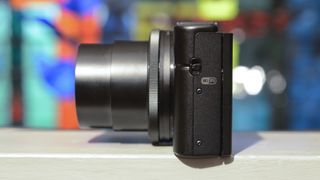
A new addition to the Sony RX100 Mark II is a hotshoe, which enables accessories, such as a viewfinder or external flash to be added to the camera. Although it doesn't have an inbuilt viewfinder, like the Panasonic LF1, the fact that you can add one is a bonus if you desire one. As it's a multi-interface hotshoe, it's compatible with a wide range of accessories.
One of the most appealing aspects of cameras such as this is the ability to shoot in raw format. However, Sony remains stubbornly committed to not allowing certain functions to be shot in raw format, including digital filters and Clear Image zoom.
While it's not a huge problem, it means that not only are you stuck with a digital filter, it also requires a pretty tedious dive into the main menu to switch raw format off to get back to where you were in the first place.
Amy has been writing about cameras, photography and associated tech since 2009. Amy was once part of the photography testing team for Future Publishing working across TechRadar, Digital Camera, PhotoPlus, N Photo and Photography Week. For her photography, she has won awards and has been exhibited. She often partakes in unusual projects - including one intense year where she used a different camera every single day. Amy is currently the Features Editor at Amateur Photographer magazine, and in her increasingly little spare time works across a number of high-profile publications including Wired, Stuff, Digital Camera World, Expert Reviews, and just a little off-tangent, PetsRadar.


